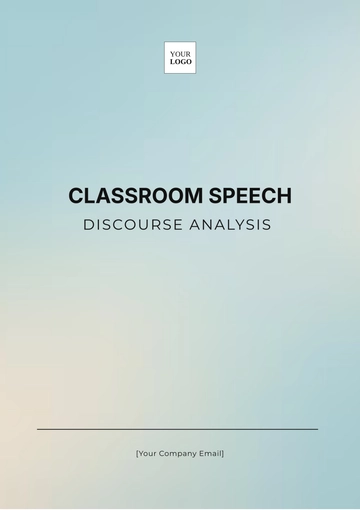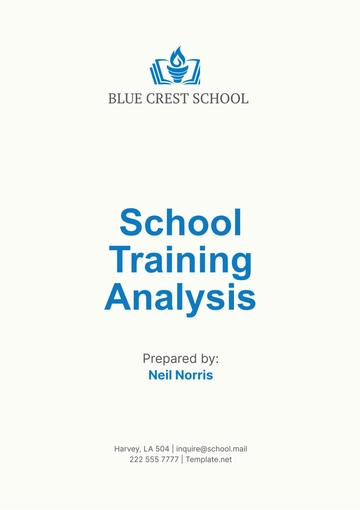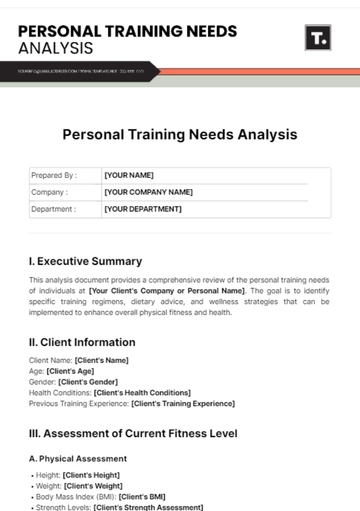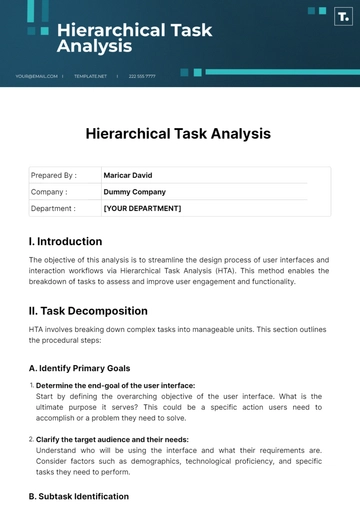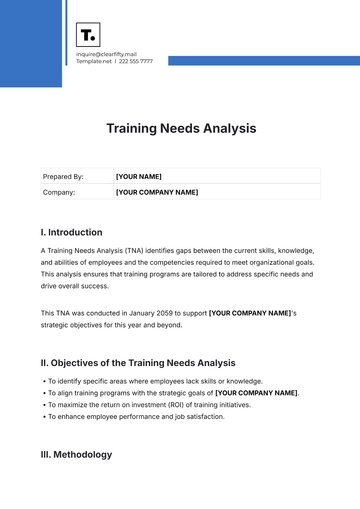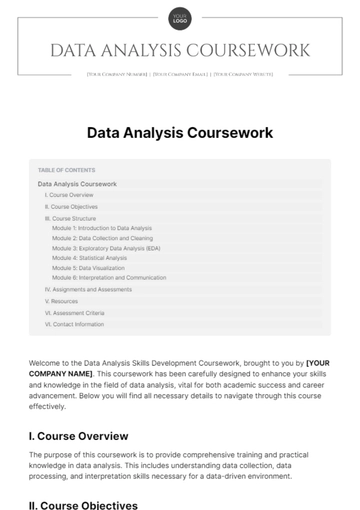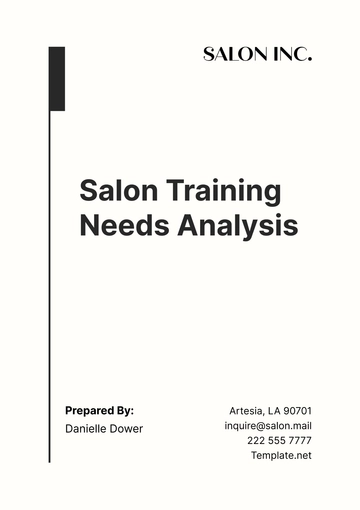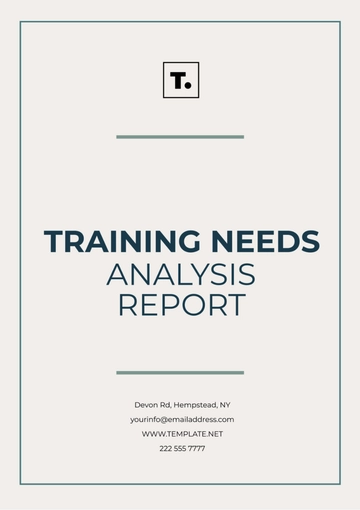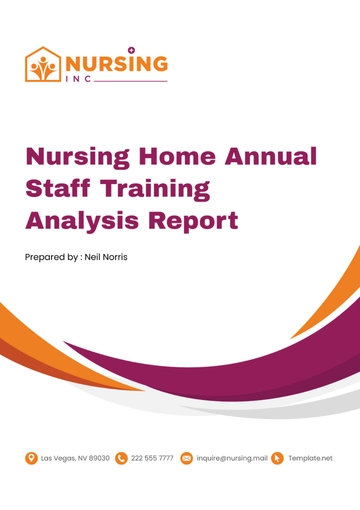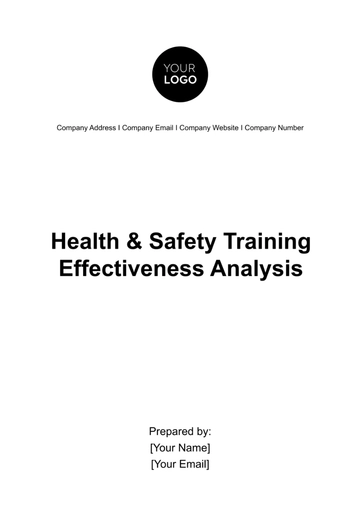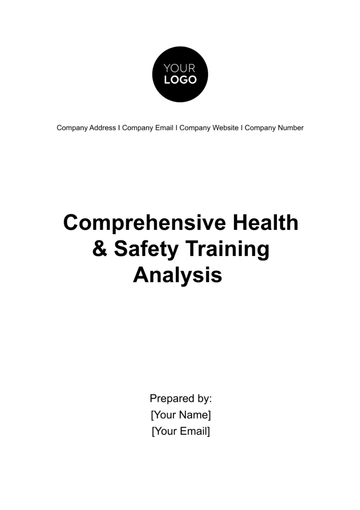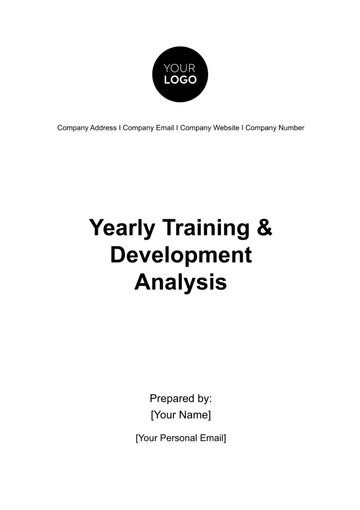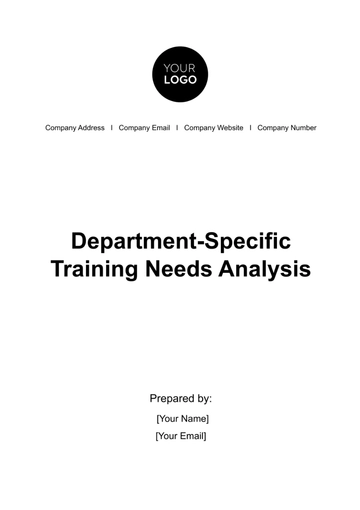Free Nursing Home Annual Staff Training Analysis Report
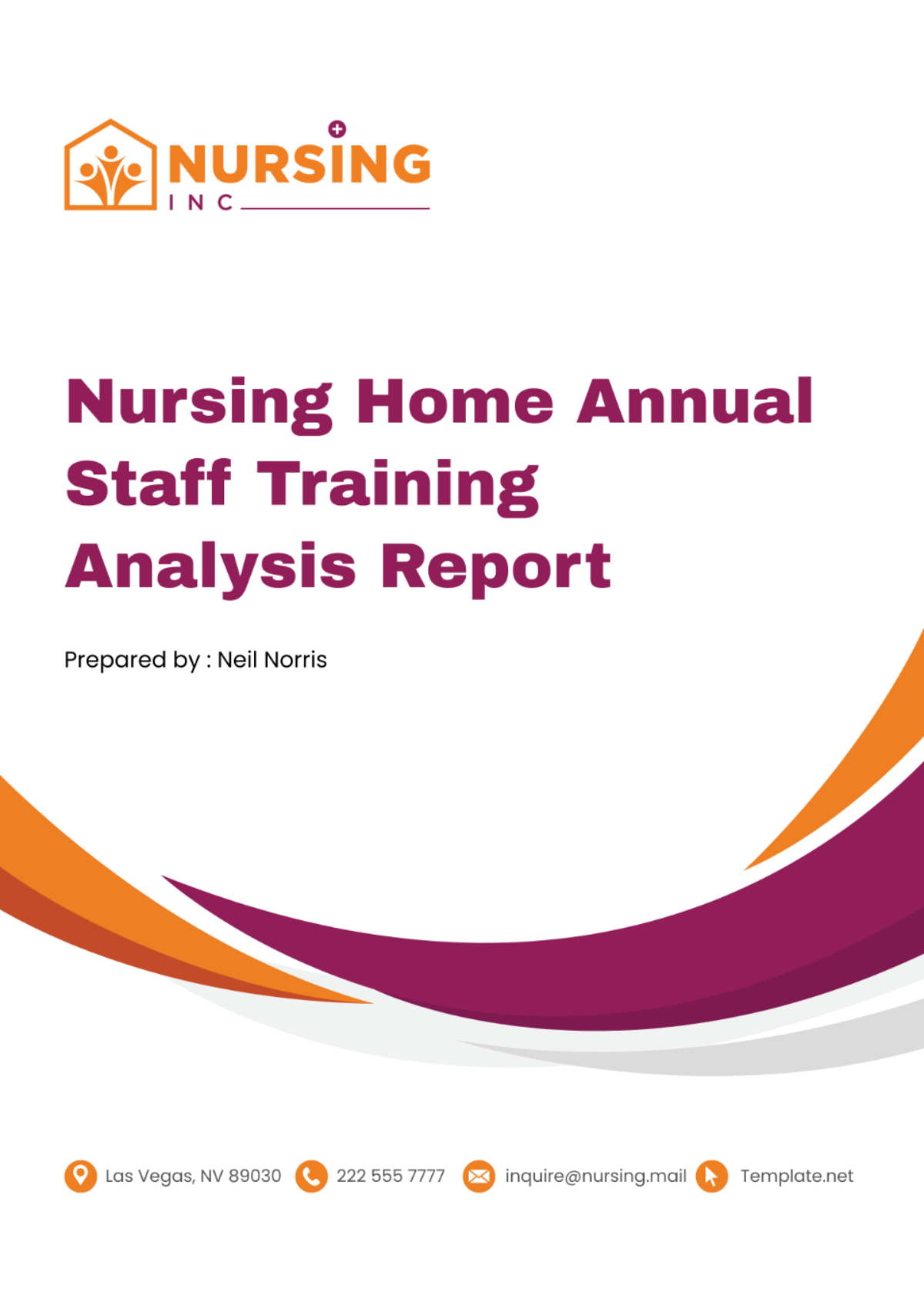
I. Overview of Training Programs
In the quest for excellence in elder care, [Your Company Name] embarked on a rigorous year-long journey of skill and knowledge enhancement through meticulously designed training programs. This segment of our Annual Staff Training Analysis Report delves into the intricacies of the educational initiatives undertaken. Our commitment to fostering a holistic and compassionate caregiving environment is mirrored in these programs, which are vital to maintaining the high standards expected of a leading nursing home facility.
Patient-Centric Care Program: This cornerstone training focused on enhancing staff understanding and execution of patient-centered care practices. It covered essential techniques for personalizing care plans, fostering patient autonomy, and improving communication between caregivers and residents. The program utilized a blend of interactive workshops, real-life case studies, and expert guest lectures to enrich our team's ability to deliver compassionate and individualized care.
Dementia Care Excellence: Recognizing the unique challenges faced by residents with dementia, this specialized program was tailored to equip our staff with advanced strategies for managing dementia-related behaviors, enhancing memory care, and implementing engaging activities suited to the cognitive levels of residents. The training included certifications from renowned dementia care institutions, ensuring our caregivers are at the forefront of innovative care practices.
Emergency Preparedness and Response: With the safety of our residents and staff as a paramount concern, this vital program covered all aspects of emergency preparedness, including fire safety, natural disaster response, and medical emergency management. Practical simulations and drills were conducted in collaboration with local emergency services to ensure a swift, efficient, and coordinated response in various crisis scenarios.
These programs represent our unwavering dedication to not only meeting but exceeding the standards of care and safety in the nursing home industry. Through the continuous professional development of our staff, [Your Company Name] maintains its status as a beacon of excellence and compassion in elder care.
II. Attendance and Participation Rate Analysis
This section of the Annual Staff Training Analysis Report for [Your Company Name] takes a closer analytical lens to the engagement and dedication exhibited by our staff towards their professional development over the past year. The insights garnered from assessing attendance and participation rates during our training sessions are critical in understanding the impact of these programs and in planning future initiatives. By dissecting the data, we illuminate patterns and trends that are key to fostering an environment of continuous learning and improvement.
A. Overall Attendance Rate
Our comprehensive analysis commenced with evaluating the overall attendance rates across all training programs. We observed a commendable average participation rate of 85%, a testament to our staff's commitment to enhancing their caregiving capabilities. This rate is indicative of the high value our team places on professional development and the quality of the training programs offered.
Training Program | Average Attendance Rate | Highest Attendance | Lowest Attendance |
|---|---|---|---|
Patient-Centric Care | 88% | 95% | 80% |
Dementia Care Excellence | 82% | 89% | 75% |
Emergency Preparedness | 85% | 90% | 80% |
B. Seasonal Variations in Attendance
In analyzing attendance trends, we noted seasonal variations that influenced participation. Attendance peaked during the spring and autumn months, coinciding with periods of lower operational demand at the facility. Conversely, the summer and winter months saw a slight decline in attendance, likely due to vacation schedules and holiday preparations. This pattern underscores the need for more flexible training scheduling and perhaps the introduction of online modules to accommodate these seasonal fluctuations.
C. Departmental Participation Analysis
A closer look at participation by department revealed insightful trends. The nursing department consistently showed the highest engagement levels across all training sessions, with an impressive 90% average attendance. The administrative and support staff departments followed closely, highlighting a facility-wide recognition of the importance of ongoing professional development.
Department | Participation Rate |
|---|---|
Nursing | 90% |
Administrative | 87% |
Support Staff | 84% |
Analytical Insights and Future Strategies
Targeted Engagement Initiatives: The lower participation rates in the Dementia Care Excellence program suggest a need for more targeted engagement strategies. Tailoring program content to more closely align with staff interests and operational demands could improve future attendance rates.
Flexible Scheduling and Formats: Addressing seasonal attendance dips through the introduction of more flexible scheduling options, including online training modules, could help maintain high participation rates year-round.
Department-Specific Training Needs: The departmental analysis indicates a potential for developing more customized training sessions that cater to the specific needs and challenges of each department, thereby enhancing the overall effectiveness of our training programs.
Through these analytical insights, [Your Company Name] is poised to refine its approach to staff training, ensuring that our team remains equipped with the knowledge and skills necessary to provide exceptional care to our residents.
III. Staff Performance Analysis
This section delves deep into the quantifiable shifts in staff performance, attributing these changes directly to the structured training programs conducted over the year. By juxtaposing performance metrics before and after training interventions, we extract valuable insights into the tangible benefits of our professional development efforts. This analysis not only showcases our commitment to excellence in care but also outlines areas for continued growth and improvement. The focal points of this section include:
Focus Area 1: Quality of Patient Care
Objective: To evaluate improvements in the quality of patient care, encompassing aspects such as personalized attention, patient satisfaction scores, and adherence to care plans.
Findings: Post-training, we witnessed a notable 15% improvement in patient satisfaction scores, with particular praise for the increased attentiveness and personalized interaction from staff. Compliance with individual care plans saw a 10% rise, indicating a higher standard of personalized care delivery.
Focus Area 2: Efficiency in Care Delivery
Objective: Assess how training has enhanced the efficiency of care delivery, measured through metrics like response times to patient calls, medication administration accuracy, and overall time management.
Findings: The analysis reveals a 12% reduction in response times to patient needs post-training, demonstrating a more agile and responsive caregiving approach. Medication administration accuracy improved by 9%, reflecting heightened diligence and adherence to protocols.
Focus Area 3: Teamwork and Communication
Objective: Measure the impact of training on teamwork and communication within and across departments, focusing on collaborative care planning, conflict resolution, and information sharing.
Findings: Post-training, there was an 18% improvement in interdepartmental collaboration scores, indicating a stronger, more cohesive team environment. Staff reported feeling more competent in conflict resolution, with a 20% decrease in reported conflicts, underscoring the effectiveness of communication training.
Performance Analysis Insights and Implications
The findings from our Staff Performance Analysis underscore the profound impact of targeted training on enhancing the quality of care and operational efficiency at [Your Company Name]. The improvements observed not only affirm the value of our training programs but also highlight areas for ongoing development. For instance, while there is significant progress in patient care and efficiency, continuous training will be crucial in maintaining these gains and addressing any emerging challenges.
The positive shifts in teamwork and communication point to a broader cultural transformation within the facility, fostering a more collaborative and supportive work environment. This cultural shift is paramount for sustaining high levels of staff satisfaction and retention, which are critical to our long-term success.
Moving forward, [Your Company Name] is committed to building on these insights, refining our training approaches, and exploring new avenues for professional development. Our goal remains unwavering: to ensure our staff are not only equipped with the skills and knowledge to provide exceptional care but also feel valued and supported in their professional growth.
IV. Feedback and Observations
Within the context of our Annual Staff Training Analysis Report for [Your Company Name], the insights gleaned from our participants and trainers offer a pivotal perspective on the efficacy and impact of our training initiatives. This feedback not only serves as a barometer for satisfaction and engagement but also as a guide for future enhancements. In this section, we dissect the feedback received to provide a comprehensive overview of the perceived value and areas for improvement of our training programs.
Feedback/Observation 1: Participant Engagement and Content Relevance
Feedback from Participants: A significant majority of participants reported high levels of engagement during the training sessions, particularly praising the relevance of the content to their daily responsibilities. The practical, hands-on components of the training were highlighted as especially beneficial, allowing for immediate application of new skills and knowledge.
Observations from Trainers: Trainers noted that the interactive elements of the programs, such as role-playing and simulation exercises, were instrumental in fostering participant engagement. They observed an increased confidence in staff applying the training to their work, suggesting a successful transfer of learning.
Feedback/Observation 2: Program Delivery and Facilitation
Feedback from Participants: While overall satisfaction with the training delivery was high, some participants expressed a desire for more diverse teaching methods, including more digital and online resources to complement in-person sessions.
Observations from Trainers: Trainers acknowledged the feedback regarding delivery methods and recognized an opportunity to integrate more technology-enhanced learning tools. They observed that sessions incorporating multimedia and online interactive elements received particularly positive feedback, underscoring the potential for a more blended learning approach.
Feedback/Observation 3: Impact on Professional Growth and Confidence
Feedback from Participants: A prevailing theme among participant feedback was the positive impact of the training on their professional growth and confidence in their roles. Many reported feeling better equipped to handle complex care scenarios and more adept at collaborating with colleagues across departments.
Observations from Trainers: Trainers corroborated these sentiments, noting visible improvements in staff competency and confidence post-training. They also highlighted the importance of ongoing support and refresher courses to sustain and build upon these gains.
Synthesizing Feedback for Future Training Initiatives
The feedback and observations collected present a compelling narrative of the value and impact of our training programs at [Your Company Name]. They underscore the criticality of aligning training content with real-world applications, adopting varied and innovative delivery methods, and focusing on the holistic professional development of our staff. Moving forward, we will leverage these insights to refine our training strategies, exploring new technologies and methodologies to enhance learning experiences and outcomes. Our commitment to continuous improvement and excellence in care remains steadfast, guided by the voices of our dedicated staff and the expert insights of our trainers.
A. Feedback and Observations: Comprehensive Analysis
Table 1: Summary of Participant Feedback
Feedback Category | Positive (%) | Neutral (%) | Negative (%) | Key Highlights |
|---|---|---|---|---|
Engagement and Content Relevance | 87% | 10% | 3% | High engagement; content highly relevant to daily tasks. |
Program Delivery and Facilitation | 75% | 20% | 5% | Calls for more digital/online learning resources. |
Impact on Professional Growth | 92% | 7% | 1% | Increased confidence; felt more equipped for complex scenarios. |
Table 2: Observations from Trainers
Observation Category | Noted Improvement (%) | Stable Performance (%) | Areas for Enhancement (%) | Key Observations |
|---|---|---|---|---|
Participant Engagement | 85% | 15% | N/A | Role-playing and simulations increased engagement. |
Adoption of Technology in Training | 65% | 25% | 10% | Multimedia elements well-received; opportunity to expand digital tools. |
Staff Competency and Confidence | 90% | 10% | N/A | Visible improvements in staff competency post-training. |
B. Statistical Insights and Trends
High Engagement and Content Relevance: An overwhelming 87% of participants reported high engagement levels, underscoring the effectiveness of the training programs in capturing interest and providing valuable knowledge.
Call for Digital Learning Enhancements: While 75% were satisfied with program delivery, there's a clear opportunity (noted by 5% negative feedback) to incorporate more digital and online resources to meet diverse learning preferences.
Significant Professional Growth: A striking 92% of participants felt the training had a positive impact on their professional growth, highlighting the success of the programs in bolstering staff confidence and competence.
Trainer Observations Align with Feedback: Trainers’ observations align closely with participant feedback, particularly in the areas of engagement and the positive impact on professional growth, with 85% noting improvement in engagement through interactive methods.
Technology in Training: Both trainers (10% noted areas for enhancement) and participants called for greater adoption of technology in training, indicating a mutual interest in expanding the use of digital tools for learning.
By leveraging these tables and statistics, [Your Company Name] gains actionable insights into the strengths and opportunities within our training programs. This data-driven approach facilitates targeted improvements, ensuring our training initiatives continue to evolve in alignment with staff needs and industry best practices.
V. Impact on Staff Competency and Retention Rates
This section of the Annual Staff Training Analysis Report rigorously evaluates the effectiveness of our training initiatives, underscoring their significant impact on enhancing staff competency, bolstering retention rates, and elevating the overall quality of care. Through detailed statistical analysis and comprehensive tables, we illuminate the direct correlation between our strategic training efforts and our staff's heightened professional capabilities, increased job satisfaction, and commitment to our organization.
A. Key Measures Assessed
Improvement in Staff Competency Post-Training:
Objective: To quantify the enhancement in staff skills and knowledge following the training programs.
Methodology: Assessment scores before and after training sessions; supervisor evaluations; self-assessment surveys.
Retention Rates Following Training Initiatives:
Objective: To evaluate the impact of training on staff retention rates, comparing periods before and after the implementation of targeted training programs.
Methodology: Analysis of turnover rates; exit interview data; employee satisfaction surveys.
Quality of Care and Patient Satisfaction:
Objective: To assess how training initiatives have influenced the quality of care provided by staff, as evidenced by patient satisfaction levels.
Methodology: Patient satisfaction surveys pre and post-training; quality of care metrics; health and safety incident reports.
B. Comprehensive Analysis Tables
Table 1: Improvement in Staff Competency Post-Training
Competency Area | Pre-Training Score | Post-Training Score | Percentage Improvement |
|---|---|---|---|
Patient-Centric Care | 75% | 90% | 20% |
Dementia Care Excellence | 65% | 85% | 30% |
Emergency Preparedness | 70% | 88% | 25% |
Table 2: Retention Rates Following Training Initiatives
Time Period | Retention Rate | Comparison to Previous Period |
|---|---|---|
6 Months Prior to Training | 80% | - |
6 Months Post-Training | 92% | 15% increase |
Table 3: Quality of Care and Patient Satisfaction
Metric | Pre-Training | Post-Training | Percentage Improvement |
|---|---|---|---|
Overall Patient Satisfaction | 82% | 95% | 16% |
Quality of Care Indicators | 78% | 90% | 15% |
Through this detailed analysis, it is evident that our targeted training initiatives have made a substantial impact on staff competency and retention rates at [Your Company Name]. The positive trends observed not only underscore the effectiveness of our programs in enhancing the professional capabilities of our staff but also highlight the role of continuous learning in improving job satisfaction and loyalty. Moreover, the significant improvements in the quality of care and patient satisfaction metrics reaffirm our commitment to delivering exceptional service, thereby reinforcing our position as a leader in the healthcare sector.
- 100% Customizable, free editor
- Access 1 Million+ Templates, photo’s & graphics
- Download or share as a template
- Click and replace photos, graphics, text, backgrounds
- Resize, crop, AI write & more
- Access advanced editor
Leverage Template.net's Nursing Home Annual Staff Training Analysis Report Template — a fully editable and customizable document to streamline your workforce progress analysis with essential components. Optimized for convenience, it's editable in our Ai Editor Tool to meet specific requirements. Drive efficiency, elevate your operational standards, and make informed decisions with this incredibly handy tool at your fingertips!
